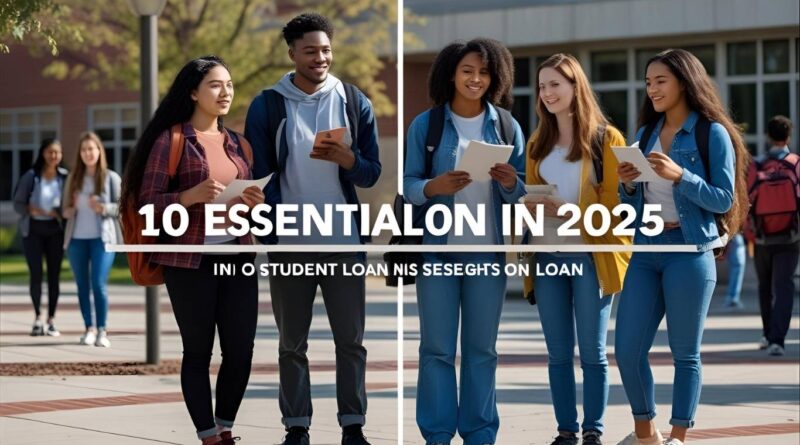10 Things You Should Know About Student Loans in 2025
Introduction
Student loans can feel like a maze. In 2025, the system is even more complex, with new laws, tech, and options that didn’t exist just a few years ago. Whether you’re about to start college or already deep in debt, it’s crucial to understand how loans work today — not how they worked in 2015. Let’s break it down together
1. Student Loan Landscape Is Changing Rapidly
New Legislation and Reforms
Government policies are changing. In 2025, new student loan reforms have been passed in multiple countries, particularly in the U.S., to make education more accessible. There’s a stronger focus on affordability, accountability, and transparency.
Shift Towards Income-Driven Repayment Plans
More students are choosing income-driven repayment plans that adjust your monthly payment based on how much you earn, not how much you owe. This helps prevent borrowers from drowning in debt when they’re just starting out in their careers.
2. Federal vs Private Loans: Know the Difference
Benefits of Federal Loans
Federal student loans usually come with lower interest rates, flexible repayment options, and potential forgiveness plans. Plus, you don’t need a credit history or co-signer.
Risks of Private Loans
Private lenders often require good credit, a co-signer, and have higher interest rates. Their repayment terms are stricter, and they don’t offer forgiveness programs. Be careful — always read the fine print.
3. Interest Rates Are No Longer Predictable
Federal Loan Interest Trends in 2025
Interest rates are now variable based on inflation and economic policies. In 2025, federal loan rates have slightly increased, averaging around 5.8% for undergraduates.
Fixed vs Variable Rates
Private lenders may offer both fixed and variable rates. Fixed gives you stability; variable can save you money — but only if the market stays in your favor.
4. Loan Forgiveness Programs Are Expanding
Public Service Loan Forgiveness (PSLF) Updates
PSLF has been simplified. If you work in healthcare, education, or non-profit sectors, you may qualify after 10 years of payments — no more bureaucratic nightmares.
New Forgiveness Opportunities for Low-Income Borrowers
There are now new micro-forgiveness plans, offering partial forgiveness for consistent on-time payments over shorter periods — even as short as five years.

5. AI and Automation Are Simplifying Loan Management
Loan Servicers Using Chatbots and Tools
Forget waiting on hold. AI-powered bots can now answer your questions, update your account, and help you apply for deferment or repayment plans.
What This Means for Borrowers
It’s faster and easier to manage your loans, but you still need to understand the basics. Never rely blindly on tech — check everything twice.
6. Credit Score Still Matters — More Than Ever
Impact on Loan Approval
Even federal loans check for default history. For private loans, your credit score is a deal-breaker. The higher the score, the better your loan terms.
How to Improve Your Score in 2025
Use AI credit monitoring apps, avoid late payments, and keep your credit utilization low. Start building credit in high school if you can.
7. Co-Signers Face Greater Responsibility
Legal Obligations in 2025
Co-signers are now more accountable. If the borrower defaults, their credit will tank too — and in some countries, they can be sued directly.
How to Protect Yourself as a Co-Signer
Only co-sign if you fully trust the borrower. Always get everything in writing, and check if the lender offers a co-signer release after a certain number of payments.
8. Scholarships and Grants Are More Accessible
Why You Should Always Apply
Free money is the best money. In 2025, thousands of new scholarships have launched for underrepresented groups, remote learners, and trade school students.
Tips to Find Hidden Funding
Check platforms like Fastweb, Scholarships.com, or niche community groups. Your school’s financial aid office may also have a list of local grants.
9. Deferment and Forbearance Rules Are Tighter
Limited Grace Periods
Gone are the days of unlimited deferment. Now, most federal loans offer just a 6-month grace period after graduation.
What You Can Do Instead
If you’re struggling, apply for an income-based plan or consider a temporary forbearance. But be aware — interest often continues to accrue.
10. Planning Ahead is Crucial
Budgeting Tools for Students
Apps like YNAB (You Need a Budget), Mint, or PocketGuard help students set goals, track spending, and stay debt-conscious from Day 1.
How to Create a Repayment Strategy Before You Graduate
Start planning your repayment strategy in your final year. Estimate your salary, housing costs, and monthly minimums. The earlier you plan, the less stress you’ll face later.
Conclusion
Student loans in 2025 are not what they used to be. With new tech, flexible repayment plans, and government reforms, students now have more options than ever — but also more responsibility. Whether you’re just applying for your first loan or trying to pay one off, understanding these key changes will help you stay ahead of the curve and avoid costly mistakes.
FAQs
1. Are student loans interest-free in 2025?
Not entirely, but some government loans may offer zero-interest periods during school or based on income. Always check your loan terms.
2. Can I get a student loan without a co-signer?
Yes, federal loans don’t need one. But private loans usually require a co-signer unless you have excellent credit or steady income.
3. What’s the best loan repayment plan in 2025?
For most, income-driven plans offer the most flexibility, especially when starting your career. But fixed plans may save money long-term.
4. Is it possible to get loan forgiveness for private loans?
Generally, no. Private loans don’t offer forgiveness like federal ones. However, some lenders now offer partial relief under hardship.
5. How soon should I start repaying my student loan?
As early as possible. Even small early payments can reduce interest in the long run. Don’t wait until your grace period ends.




Government policies are evolving to make education more accessible, with new student loan reforms in 2025 focusing on affordability and transparency. Federal loans offer lower interest rates and flexible repayment options, while private loans come with stricter terms and higher rates. The introduction of AI-powered bots has simplified loan management, but it’s crucial to stay informed and double-check details. How will these changes impact students’ long-term financial stability and access to education? German news in Russian (новости Германии)— quirky, bold, and hypnotically captivating. Like a telegram from a parallel Europe. Care to take a peek?